
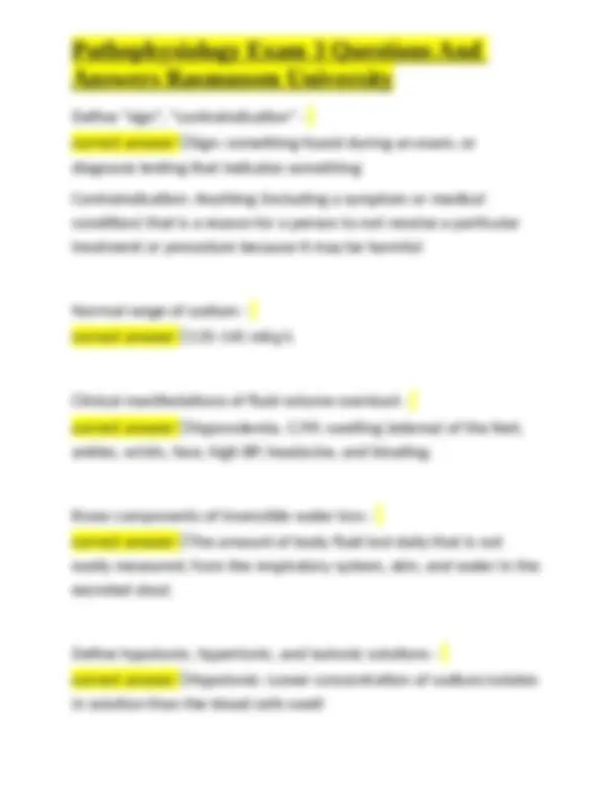
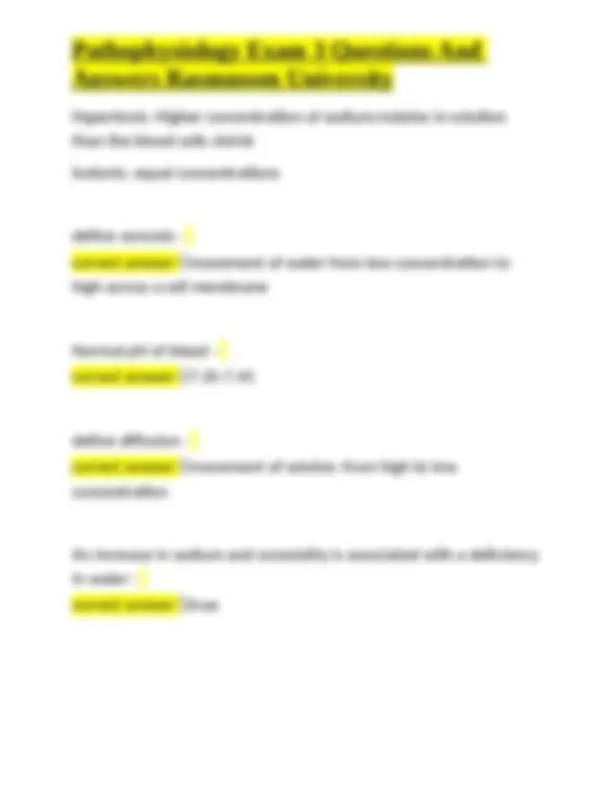
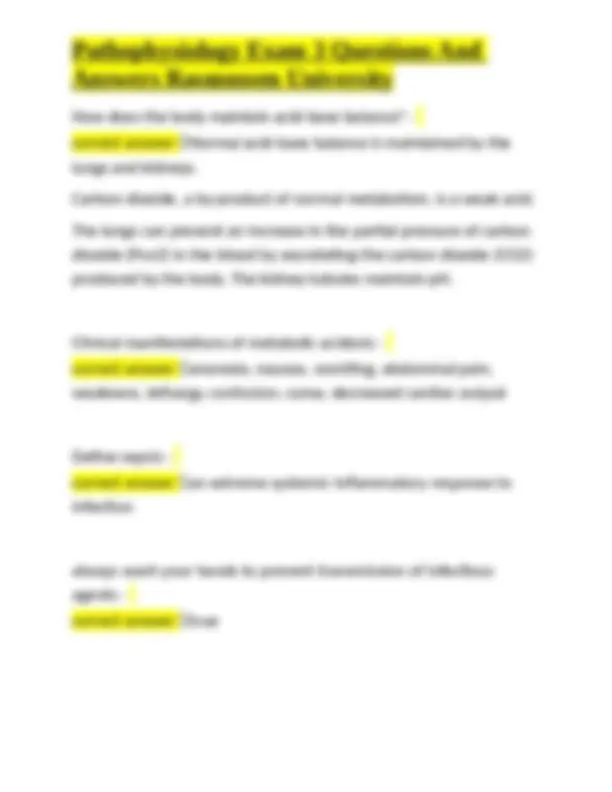
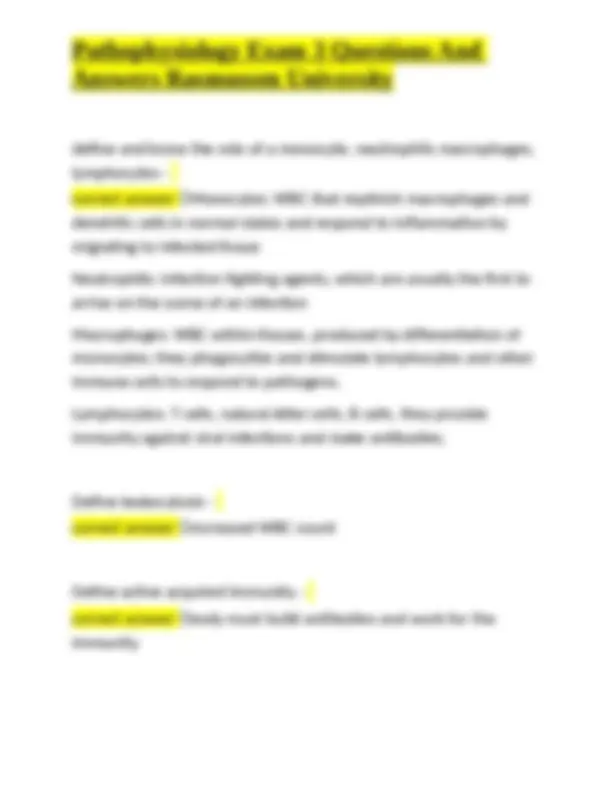
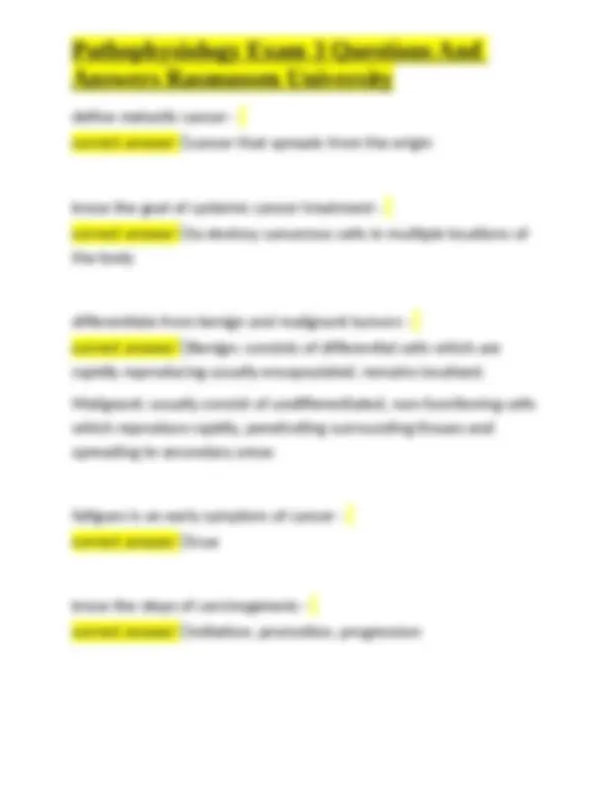
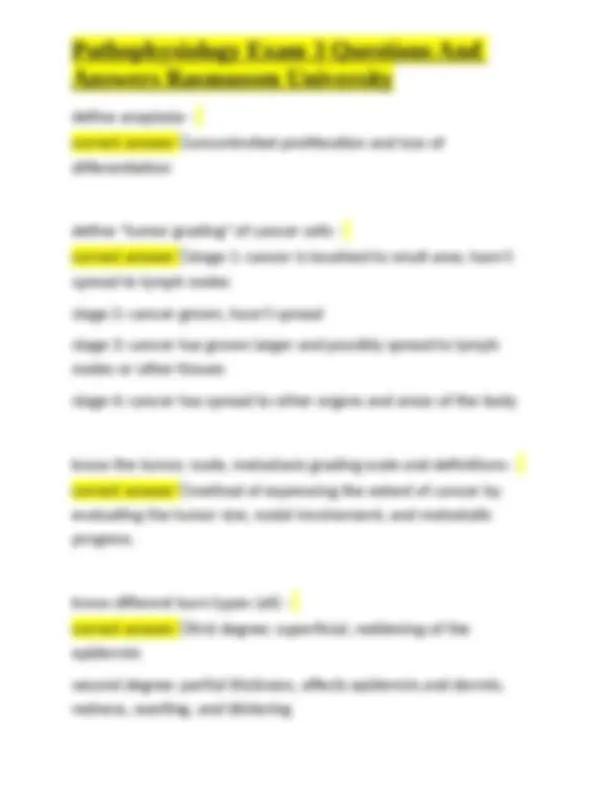
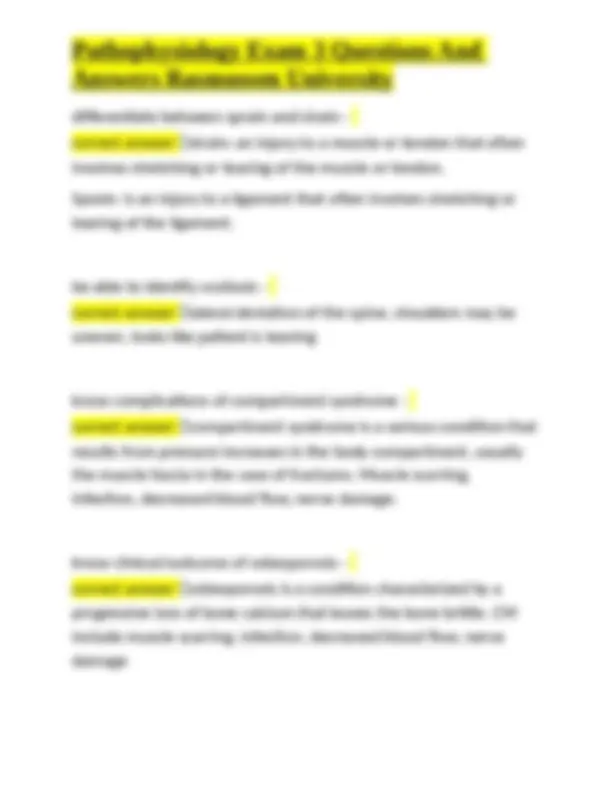
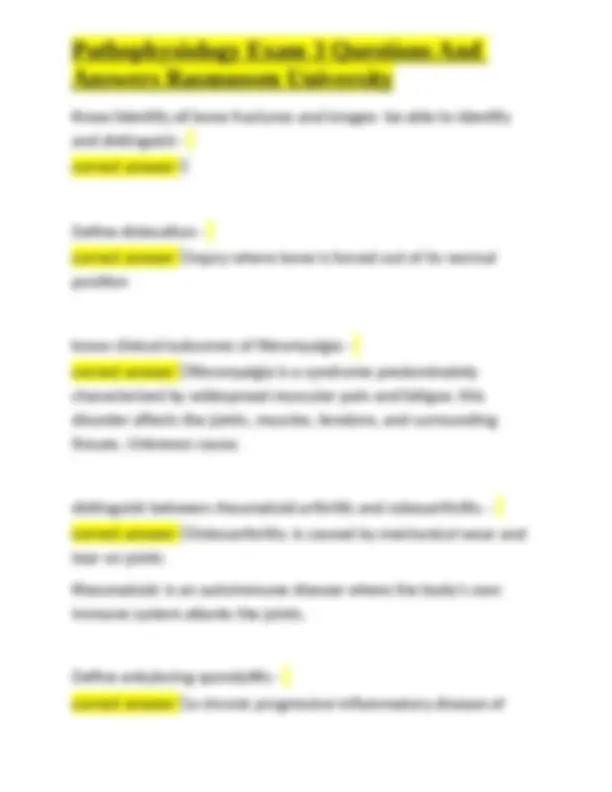
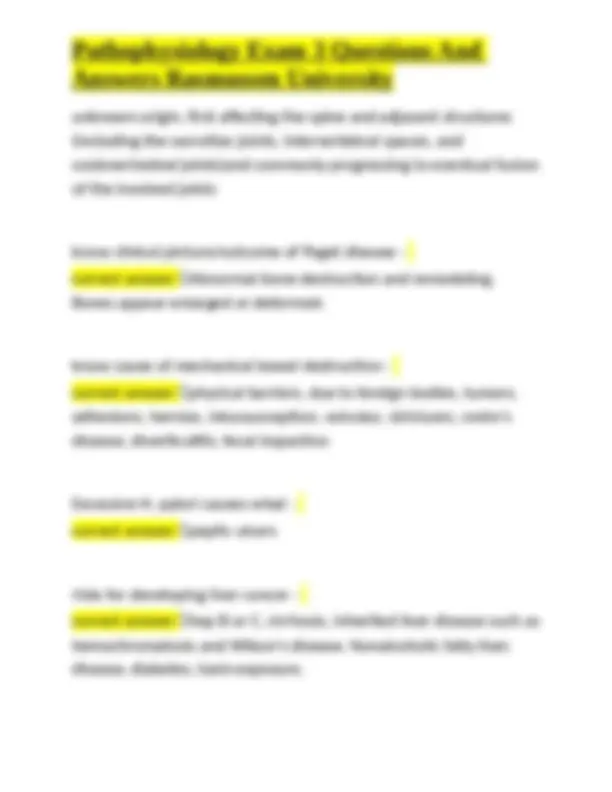
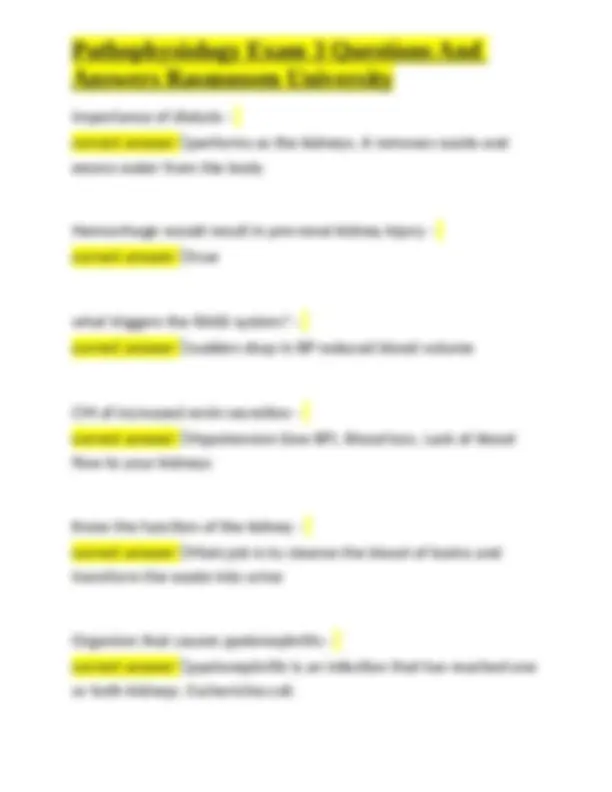
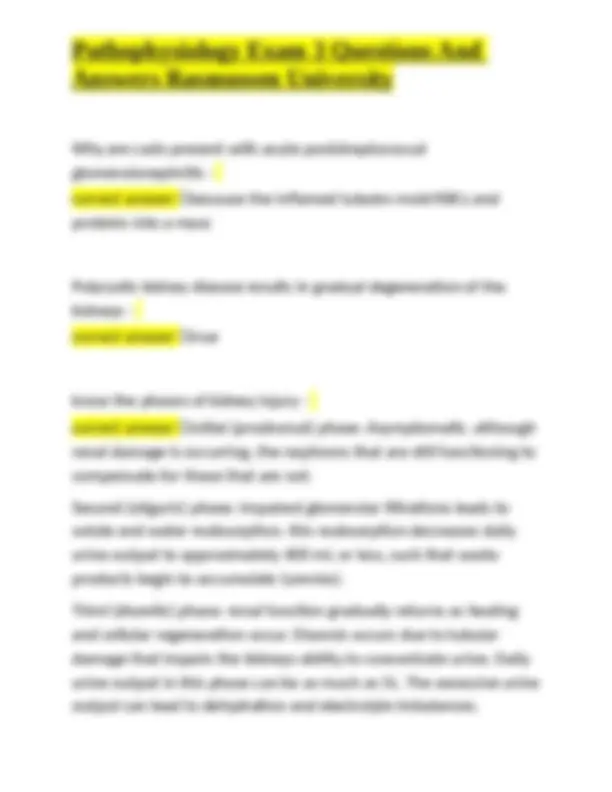
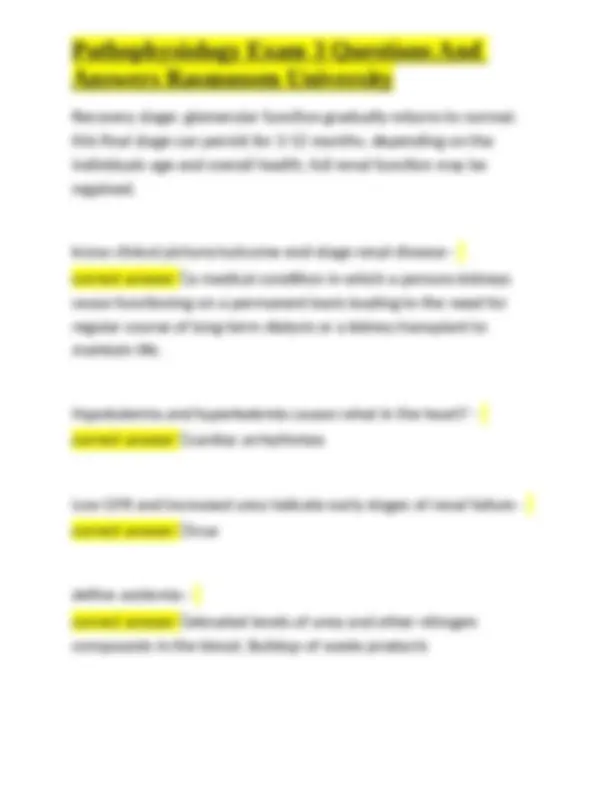
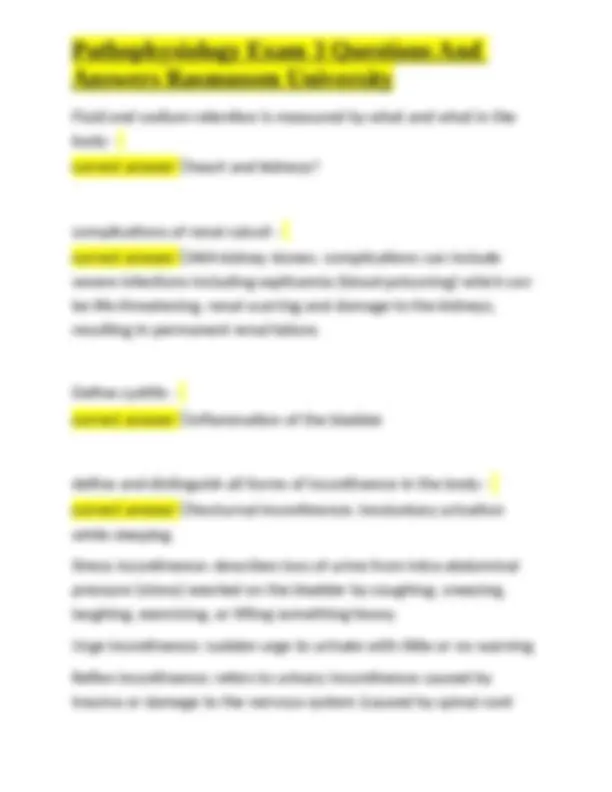
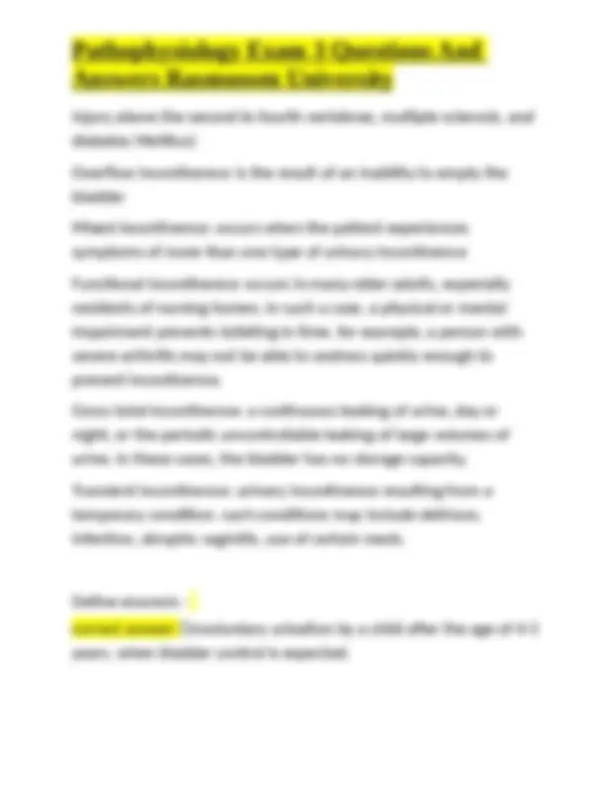
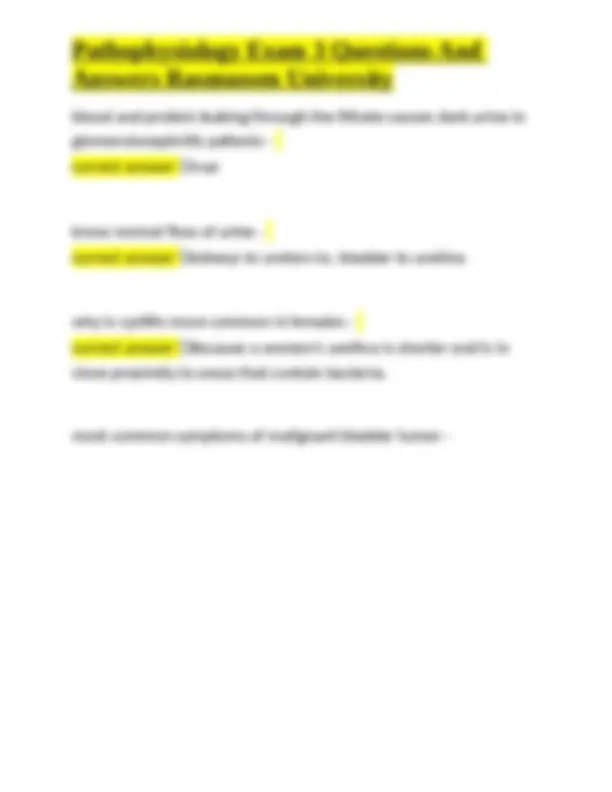


Study with the several resources on Docsity

Earn points by helping other students or get them with a premium plan


Prepare for your exams
Study with the several resources on Docsity

Earn points to download
Earn points by helping other students or get them with a premium plan
Community
Ask the community for help and clear up your study doubts
Discover the best universities in your country according to Docsity users
Free resources
Download our free guides on studying techniques, anxiety management strategies, and thesis advice from Docsity tutors
Pathophysiology Exam 3 Questions And Answers Rasmussen University
Typology: Exams
1 / 23

This page cannot be seen from the preview
Don't miss anything!
















Physiological concepts of flight or fight response? - correct answer ✅The release of catecholamines and cortisol during the alarm stage of the generalized adaptation syndrome. SNS triggers an acute stress response. Pupils dilate, HR and BP increases, bladder relaxes. Define Homeostasis. - correct answer ✅Equilibrium of the body. Function of a ribosome? - correct answer ✅Aid in protein production. Hormone that raises blood sugar? - correct answer ✅Glucagon Main function of the endocrine system? - correct answer ✅The glands of the endocrine system secrete a wide range of hormones and chemical messengers that help regulate growth, development, mood metabolism, and reproduction.
Function of plasma protein? - correct answer ✅Albumin, globulins, and fibrinogen. Maintains osmotic pressure, coagulation factors, transports antibodies, hormones, lipids, vitamins, and minerals. Intracellular contain a high ____- note which electrolytes - correct answer ✅Potassium, magnesium and phosphate Physiologic effect of hyponatremia? - correct answer ✅Results from low serum sodium levels (< mEq/L). As sodium levels decrease, water shifts into cells. This can cause unstable gait, osteoporosis, attention deficit, cells swell. Define hypovolemia - correct answer ✅fluid deficit in the intravascular compartment This stores electrolytes and acts like an electrolyte pool in the body
correct answer ✅the kidneys
Hypertonic: Higher concentration of sodium/solutes in solution than the blood cells shrink Isotonic: equal concentrations define osmosis - correct answer ✅movement of water from low concentration to high across a cell membrane Normal pH of blood - correct answer ✅7.35-7. define diffusion - correct answer ✅movement of solutes: from high to low concentration An increase in sodium and osmolality is associated with a deficiency in water - correct answer ✅true
How does the body maintain acid-base balance? - correct answer ✅Normal acid-base balance is maintained by the lungs and kidneys. Carbon dioxide, a by-product of normal metabolism, is a weak acid. The lungs can prevent an increase in the partial pressure of carbon dioxide (Pco2) in the blood by excreteting the carbon dioxide (CO2) produced by the body. The kidney tubules maintain pH. Clinical manifestations of metabolic acidosis - correct answer ✅anorexia, nausea, vomiting, abdominal pain, weakness, lethargy, confusion, coma, decreased cardiac output Define sepsis - correct answer ✅an extreme systemic inflammatory response to infection always wash your hands to prevent transmission of infectious agents - correct answer ✅true
Systemic effect during an inflammatory response - correct answer ✅systemic inflammatory response syndrome (SIRS) is an exaggerated defense response of the body to noxious stressor (infection, trauma, surgery, acute inflammation, ischemia, or reperfusion, or malignancy) to localize and then eliminate the endogenous or exogenous source of the insult. Clinical manifestations of anaphylaxis - correct answer ✅a severe, potentially life threatening allergic reaction. CM include swelling, difficulty breathing/ swallowing, shortness of breath, chest tightness, wheezing, cramps, hives, etc. disorders associated with an excessive immune response - correct answer ✅asthma, systemic anaphylaxis, due to inflammation passive immunity - correct answer ✅the immunity is given to you already, body does not have to work for it define autoimmune disease - correct answer ✅the bodys immune system attacks healthy cells. its an overactive and inappropriate immune response.
define and know the role of a monocyte, neutrophils macrophages, lymphocytes - correct answer ✅Monocytes: WBC that replinish macrophages and dendritic cells in normal states and respond to inflammation by migrating to infected tissue Neutrophils: infection fighting agents, which are usually the first to arrive on the scene of an infection Macrophages: WBC within tissues, produced by differentiation of monocytes; they phagocytize and stimulate lymphocytes and other immune cells to respond to pathogens. Lymphocytes: T cells, natural killer cells, B cells. they provide immunity against viral infections and make antibodies. Define leukocytosis - correct answer ✅increased WBC count Define active acquired immunity - correct answer ✅body must build antibodies and work for the immunity
define anaplasia - correct answer ✅uncontrolled proliferation and loss of differentiation define "tumor grading" of cancer cells - correct answer ✅stage 1: cancer is localized to small area, hasn't spread to lymph nodes stage 2: cancer grown, hasn't spread stage 3: cancer has grown larger and possibly spread to lymph nodes or other tissues stage 4: cancer has spread to other organs and areas of the body know the tumor, node, metastasis grading scale and definitions - correct answer ✅method of expressing the extent of cancer by evaluating the tumor size, nodal involvement, and metastatic progress. know different burn types (all) - correct answer ✅first degree: superficial, reddening of the epidermis second degree: partial thickness, affects epidermis and dermis, redness, swelling, and blistering
third degree: full thickness, affects deeper tissue, charred skin that may be blacked and numb know what to look for/ assess in a patient with atopic dermatitis - correct answer ✅dry, itchy skin, blistering, most reddened skin, white patches know clinical picture/outcome of pediculosis patient - correct answer ✅lice. 1-3mm long prevention methods of squamous cell carcinoma - correct answer ✅using sunscreen wearing protective clothing avoid self tanning know clinical picture/outcome of atopic dermatitis - correct answer ✅exudative lesions, erythema, and scaling around the eyes. creases of the skin are mostly affected. know changes in elderly skin - correct answer ✅it becomes thinner, loses fat and elasticity
differentiate between sprain and strain - correct answer ✅strain: an injury to a muscle or tendon that often involves stretching or tearing of the muscle or tendon. Sprain: is an injury to a ligament that often involves stretching or tearing of the ligament. be able to identify scoliosis - correct answer ✅lateral deviation of the spine, shoulders may be uneven, looks like patient is leaning know complications of compartment syndrome - correct answer ✅compartment syndrome is a serious condition that results from pressure increases in the body compartment, usually the muscle fascia in the case of fractures. Muscle scarring, infection, decreased blood flow, nerve damage. know clinical/outcome of osteoporosis - correct answer ✅osteoporosis is a condition characterized by a progressive loss of bone calcium that leaves the bone brittle. CM include muscle scarring, infection, decreased blood flow, nerve damage
Know/identify all bone fractures and images- be able to identify and distinguish - correct answer ✅ Define dislocation - correct answer ✅injury where bone is forced out of its normal position know clinical/outcomes of fibromyalgia - correct answer ✅fibromyalgia is a syndrome predominately characterized by widespread muscular pain and fatigue. this disorder affects the joints, muscles, tendons, and surrounding tissues. Unknown cause. distinguish between rheumatoid arthritis and osteoarthritis. - correct answer ✅Osteoarthritis: is caused by mechanical wear and tear on joints Rheumatoid: is an autoimmune disease where the body's own immune system attacks the joints. Define ankylosing spondylitis - correct answer ✅a chronic progressive inflammatory disease of
Patient most at risk for intestinal obstruction - correct answer ✅people who've had abdominal surgery patient most likely to develop pancreatic cancer - correct answer ✅patients with intestinal adhesions from surgery, those with hernias, or colon cancer which patient is most likely to develop hepatitis B, presentation of disease - correct answer ✅Babies during childbirth, drug users, health care providers, people with multiple sex partners, gay men, dialysis patients, inmates, pregnant women Hepatitis A is mainly transmitted by the oral-fecal route - correct answer ✅true know clinical picture/outcome esophageal varices - correct answer ✅esophageal varies are enlarged veins in the esophagus. they're often due to obstructed blood flow through the portal vein, which carries blood from the intestine, pancreas, and spleen to the liver.
symptoms of liver disease - correct answer ✅jaundice, abdominal pain and swelling, swelling in the legs, nausea know the clinical picture/outcome esophageal cancer - correct answer ✅difficulty swallowing, abnormal weight loss, chest pain/pressure, indigestion know complications of end-stage liver cirrhosis - correct answer ✅ascites, encephalopathy, portal hypertension, vatical bleeding, hepatorenal syndrome Main CM of gastric ulcers - correct answer ✅upper abdominal pain, chest pain, fatty food intolerance, nausea, vomiting burning stomach pain physical assessment technique that assesses kidney disease - correct answer ✅palpate behind the rib cage and iliac crest , and right coastal margin. Press and ask patient to take deep breaths. Feel for lower pole of the kidney.
Why are casts present with acute poststreptococcal glomerulonephritis - correct answer ✅because the inflamed tubules mold RBCs and proteins into a mass Polycystic kidney disease results in gradual degeneration of the kidneys - correct answer ✅true know the phases of kidney injury - correct answer ✅initial (prodromal) phase: Asymptomatic. although renal damage is occurring, the nephrons that are still functioning to compensate for those that are not. Second (oliguric) phase: impaired glomerular filtrations leads to solute and water reabsorption. this reabsorption decreases daily urine output to approximately 400 mL or less, such that waste products begin to accumulate (uremia). Third (diuretic) phase: renal function gradually returns as healing and cellular regeneration occur. Diuresis occurs due to tubular damage that impairs the kidneys ability to concentrate urine. Daily urine output in this phase can be as much as 5L. The excessive urine output can lead to dehydration and electrolyte imbalances.
Recovery stage: glomerular function gradually returns to normal. this final stage can persist for 3-12 months. depending on the individuals age and overall health, full renal function may be regained. know clinical picture/outcome end-stage renal disease - correct answer ✅a medical condition in which a persons kidneys cease functioning on a permanent basis leading to the need for regular course of long-term dialysis or a kidney transplant to maintain life. Hypokalemia and hyperkalemia causes what in the heart? - correct answer ✅cardiac arrhythmias Low GFR and increased urea indicate early stages of renal failure - correct answer ✅true define azotemia - correct answer ✅elevated levels of urea and other nitrogen compounds in the blood. Buildup of waste products